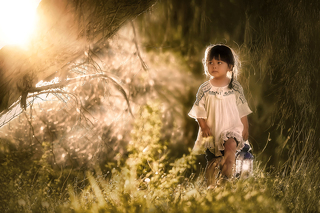Despird Zhang: Child in the scene is only a reflection of myself

We tend to think that children's photography is a story about happiness and carelessness. However, children's photographer and member of the World Professional Photographers Organization Despird Zhang proves that photography is not just about a nice picture, but also a reflection of one’s soul.
- Tell us please a bit about yourself. Where did you grow up?
- I was born and raised in Northeast China. 13 years ago, my wife and I moved to Perth, Australia. Now I have three children, two boys and a girl.

- Was photography your first choice of a career?
- Not really, my background is in science and engineering, and I am a professional software developer.

- Why did you decide to specialize in kids’ photography?
- The time spent with children has always been a great help to me in gathering materials for my photos. On the other hand, I believe that sometimes the child in the scene is a reflection of myself.

|
- Who were your biggest influences when you started? Now?
- Iwona Podlasińska (Poland) had a very deep influence on me in the early years. But later, I started trying to inject into my creations an indescribable or destructive mood that makes them the opposite of daydreaming and fantasizing. I especially like the works of Sebastian Kisworo (Indonisia), Charlaine Gerber (South Africa) and Teruhiko Tsuchida (Japan).

- Describe your photographic style. And how did you develop it?
- When it comes to children photography, some key words come to mind: cheerful, bright, innocent, lovely, happy, playful, dreamy, fairy, beautiful... which are generally considered appropriate for children’s portraits description.
In my early creations, I was trying to embrace those factors. But one day I realized this just wasn’t working out for me. I am an amateur self-taught photographer with no decent art education. And I have a pretty bad sense of color.
I took a long break and began to ponder the aesthetic implications of these words. The conclusion is ironic and bitter: I have to be careful with those because once they do not reflect anything that I would like to express at a particular moment, the result isn’t going to be very pleasant. I cannot create a work that is deemed to be satisfying every time. And I fail all the time, even today.
As a result of such self-destruction and reconstruction, something new began to emerge in my “photographic language”. I am aware that the child in the scene is only a reflection of myself, my fear and stress, and sometimes nostalgia. What lurks under my hard shell is loneliness and fear which used to lead to nightmares and insomnia during the endless nights. In many cases, strong lights and shadows aren’t symbols of a dreamy childhood, but a metaphor, suppressed by unknown external powers, which succumbs to real-life obligations.
I prefer black and white photography in terms of simple composition and post-editing. Sometimes I am too obsessed with lights and shadows, and strong vignettes that have received much criticism. But for me that makes sense because it helps to explain the nature of light: itcomes from darkness and is always on its own. Eventually it will be devoured by darkness again, but it’ll leave indelible marks.

- Which editing software do you usually use?
- Mostly Photoshop (using Nik Collection filters). Sometimes 3D LUT Creator.

- What kind of gear do you use?
- Nikon DSLRs (D750 and D5100), Sony mirrorless A7III. Prime lens 85mm, zoom lens 24-70.

- Do you prefer shooting outdoors or indoors?
- As far as possible, I shoot outdoors, but sometimes a sudden whim provides a nice indoor shot.

- What attracts you to participate in 35AWARDS?
- A large number of participants and that some of them are award-winning photographers. The quality of the winning works are very reassuring.

- Describe your expectations from participating in WPPO.
- I believe this to be a great opportunity for me to meet worldfamous photographers and artists.






